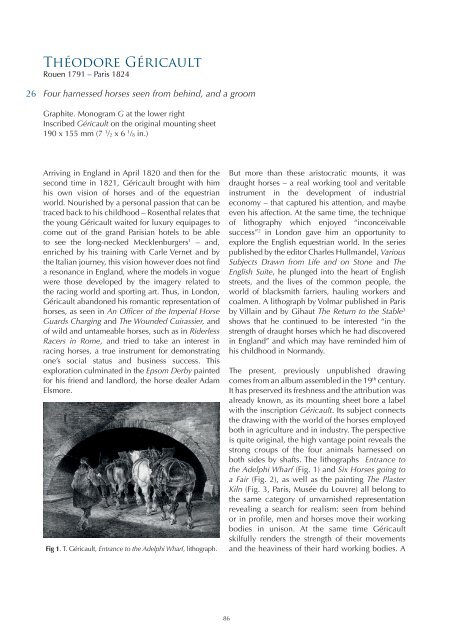XV - Works On Paper - Marty de Cambiaire (English)
Create successful ePaper yourself
Turn your PDF publications into a flip-book with our unique Google optimized e-Paper software.
Théodore Géricault<br />
Rouen 1791 – Paris 1824<br />
26<br />
Four harnessed horses seen from behind, and a groom<br />
Graphite. Monogram G at the lower right<br />
Inscribed Géricault on the original mounting sheet<br />
190 x 155 mm (7 1 /2 x 6 1 /8 in.)<br />
Arriving in England in April 1820 and then for the<br />
second time in 1821, Géricault brought with him<br />
his own vision of horses and of the equestrian<br />
world. Nourished by a personal passion that can be<br />
traced back to his childhood – Rosenthal relates that<br />
the young Géricault waited for luxury equipages to<br />
come out of the grand Parisian hotels to be able<br />
to see the long-necked Mecklenburgers 1 – and,<br />
enriched by his training with Carle Vernet and by<br />
the Italian journey, this vision however does not find<br />
a resonance in England, where the mo<strong>de</strong>ls in vogue<br />
were those <strong>de</strong>veloped by the imagery related to<br />
the racing world and sporting art. Thus, in London,<br />
Géricault abandoned his romantic representation of<br />
horses, as seen in An Officer of the Imperial Horse<br />
Guards Charging and The Woun<strong>de</strong>d Cuirassier, and<br />
of wild and untameable horses, such as in Ri<strong>de</strong>rless<br />
Racers in Rome, and tried to take an interest in<br />
racing horses, a true instrument for <strong>de</strong>monstrating<br />
one’s social status and business success. This<br />
exploration culminated in the Epsom Derby painted<br />
for his friend and landlord, the horse <strong>de</strong>aler Adam<br />
Elsmore.<br />
Fig 1. T. Géricault, Entrance to the A<strong>de</strong>lphi Wharf, lithograph.<br />
But more than these aristocratic mounts, it was<br />
draught horses – a real working tool and veritable<br />
instrument in the <strong>de</strong>velopment of industrial<br />
economy – that captured his attention, and maybe<br />
even his affection. At the same time, the technique<br />
of lithography which enjoyed “inconceivable<br />
success” 2 in London gave him an opportunity to<br />
explore the <strong>English</strong> equestrian world. In the series<br />
published by the editor Charles Hullman<strong>de</strong>l, Various<br />
Subjects Drawn from Life and on Stone and The<br />
<strong>English</strong> Suite, he plunged into the heart of <strong>English</strong><br />
streets, and the lives of the common people, the<br />
world of blacksmith farriers, hauling workers and<br />
coalmen. A lithograph by Volmar published in Paris<br />
by Villain and by Gihaut The Return to the Stable 3<br />
shows that he continued to be interested “in the<br />
strength of draught horses which he had discovered<br />
in England” and which may have remin<strong>de</strong>d him of<br />
his childhood in Normandy.<br />
The present, previously unpublished drawing<br />
comes from an album assembled in the 19 th century.<br />
It has preserved its freshness and the attribution was<br />
already known, as its mounting sheet bore a label<br />
with the inscription Géricault. Its subject connects<br />
the drawing with the world of the horses employed<br />
both in agriculture and in industry. The perspective<br />
is quite original, the high vantage point reveals the<br />
strong croups of the four animals harnessed on<br />
both si<strong>de</strong>s by shafts. The lithographs Entrance to<br />
the A<strong>de</strong>lphi Wharf (Fig. 1) and Six Horses going to<br />
a Fair (Fig. 2), as well as the painting The Plaster<br />
Kiln (Fig. 3, Paris, Musée du Louvre) all belong to<br />
the same category of unvarnished representation<br />
revealing a search for realism: seen from behind<br />
or in profile, men and horses move their working<br />
bodies in unison. At the same time Géricault<br />
skilfully ren<strong>de</strong>rs the strength of their movements<br />
and the heaviness of their hard working bodies. A<br />
86
















